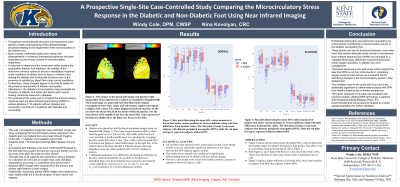Clinical Research
(CR-016) A Prospective Single-site Case-controlled Study Examining the Differences in Microcirculatory Stress Responses Between Diabetic and Non-diabetic Feet Using an Advanced Near-infrared Imaging System
Friday, May 2, 2025
7:45 PM - 8:45 PM East Coast USA Time

Nina Kovolyan, CRC – Wound Care Research – Kent State University
Introduction: Conducting a comprehensive diabetic foot assessment is essential, particularly when it comes to screening for limb perfusion to detect early-stage peripheral artery disease (PAD). While no single method for non-invasive vascular studies (NIVS) stands out as the gold standard, several clinical options are available. However, in diabetic patients, these tests often yield inaccurate results, potentially leading clinicians to mistakenly conclude that adequate perfusion exists in the diabetic foot. This study aimed to compare the microcirculatory responses of individuals without diabetes against those suffering from diabetic neuropathy when subjected to a series of controlled stressors. The key objective was to clearly demonstrate that the microcirculatory stress response is significantly compromised in diabetic neuropathic feet, and to establish that Near-infrared spectroscopy (NIRS) serves as an effective tool for identifying these crucial changes.
Methods: This groundbreaking study is a prospective single-site case-controlled investigation that examined the crucial differences in microcirculatory stress responses between diabetic and non-diabetic feet using Near-Infrared Spectroscopy (NIRS). Involving 20 subjects, we meticulously conducted the study after thorough screening and obtaining informed consent. Each participant underwent a series of NIRS imaging sessions, exposed to five minutes of targeted stresses, such as heat (via heating pads), cold (using ice packs), elevation, and dependency of the right foot, all within a carefully controlled clinic environment.
Results: This study compellingly highlights a significant discrepancy in the microcirculatory response to various stresses between individuals with and without diabetic neuropathy. Moreover, these findings reinforce the critical insight that the microcirculatory stress response is significantly impaired in the diabetic neuropathic foot, underscoring the need for targeted interventions in affected patients.
Discussion: Endothelial dysfunction and autonomic neuropathy are critical factors contributing to microcirculation issues in the diabetic neuropathic foot. These factors can lead to functional ischemia, even when blood flow seems adequate under normal circumstances. Near-Infrared Spectroscopy (NIRS) has emerged as a validated technology, effectively measuring functional tissue oxygen saturation in diabetic foot ulcer management. The promising results from this pilot study further support the idea that NIRS is not only instrumental in monitoring oxygen levels but also serves as a powerful tool for identifying changes in the microcirculatory system of the diabetic foot.
Methods: This groundbreaking study is a prospective single-site case-controlled investigation that examined the crucial differences in microcirculatory stress responses between diabetic and non-diabetic feet using Near-Infrared Spectroscopy (NIRS). Involving 20 subjects, we meticulously conducted the study after thorough screening and obtaining informed consent. Each participant underwent a series of NIRS imaging sessions, exposed to five minutes of targeted stresses, such as heat (via heating pads), cold (using ice packs), elevation, and dependency of the right foot, all within a carefully controlled clinic environment.
Results: This study compellingly highlights a significant discrepancy in the microcirculatory response to various stresses between individuals with and without diabetic neuropathy. Moreover, these findings reinforce the critical insight that the microcirculatory stress response is significantly impaired in the diabetic neuropathic foot, underscoring the need for targeted interventions in affected patients.
Discussion: Endothelial dysfunction and autonomic neuropathy are critical factors contributing to microcirculation issues in the diabetic neuropathic foot. These factors can lead to functional ischemia, even when blood flow seems adequate under normal circumstances. Near-Infrared Spectroscopy (NIRS) has emerged as a validated technology, effectively measuring functional tissue oxygen saturation in diabetic foot ulcer management. The promising results from this pilot study further support the idea that NIRS is not only instrumental in monitoring oxygen levels but also serves as a powerful tool for identifying changes in the microcirculatory system of the diabetic foot.

.jpg)